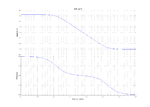al3ko
Junior Member level 3
Dear community,
I'll have to implement a current mode control for keeping the output voltage of a boost converter constant. The converter is operating in CCM meaning the current through the inductor is never reaching 0 A.
I know the principles of current mode control with sensing the current through the switch path via a shunt/sensing resistor (or current transformer) and also the outer loop with the output voltage and the error amplifier.
The problem is, that I don't know how to design
(1) Error Amplifier compensation network for stabilizing the closed loop
(2) Find a value for the sensing resistor
I'll use the UC3842. I've also read its datasheet and I know the topologies for the slope compensation, the error amplifier etc.
But I am unable to find appropriate values for the passive components. For example:
How do I estimate the parameters for the error amplifier compensation network?
I did read books and application notes about closing the feedback loop (Fundamentals of Power Electronics, Control Loop Cookbook etc.) but they all require an exact model of the boost converter. And the model, however, is mostly given in control-to-output with the output voltage over the duty cycle (which is needed for voltage mode control).
My question to you:
How can I estimate the components for my feedback compensation network without knowing the transfer function (output voltage over inductor current)? If the transfer function is necessary, how do I obtain it easily?
I want to thank you all for your patients and help. You definitely would help me a lot because I am really lost after spending much time on reading stuff about that
Kindly,
al3ko
PS: The aim is to keep the output voltage constant. There won't be big load steps or any big disturbances or input changes or anything like that. So there's no need for a high bandwidth I guess.
I'll have to implement a current mode control for keeping the output voltage of a boost converter constant. The converter is operating in CCM meaning the current through the inductor is never reaching 0 A.
I know the principles of current mode control with sensing the current through the switch path via a shunt/sensing resistor (or current transformer) and also the outer loop with the output voltage and the error amplifier.
The problem is, that I don't know how to design
(1) Error Amplifier compensation network for stabilizing the closed loop
(2) Find a value for the sensing resistor
I'll use the UC3842. I've also read its datasheet and I know the topologies for the slope compensation, the error amplifier etc.
But I am unable to find appropriate values for the passive components. For example:
How do I estimate the parameters for the error amplifier compensation network?
I did read books and application notes about closing the feedback loop (Fundamentals of Power Electronics, Control Loop Cookbook etc.) but they all require an exact model of the boost converter. And the model, however, is mostly given in control-to-output with the output voltage over the duty cycle (which is needed for voltage mode control).
My question to you:
How can I estimate the components for my feedback compensation network without knowing the transfer function (output voltage over inductor current)? If the transfer function is necessary, how do I obtain it easily?
I want to thank you all for your patients and help. You definitely would help me a lot because I am really lost after spending much time on reading stuff about that
Kindly,
al3ko
PS: The aim is to keep the output voltage constant. There won't be big load steps or any big disturbances or input changes or anything like that. So there's no need for a high bandwidth I guess.

